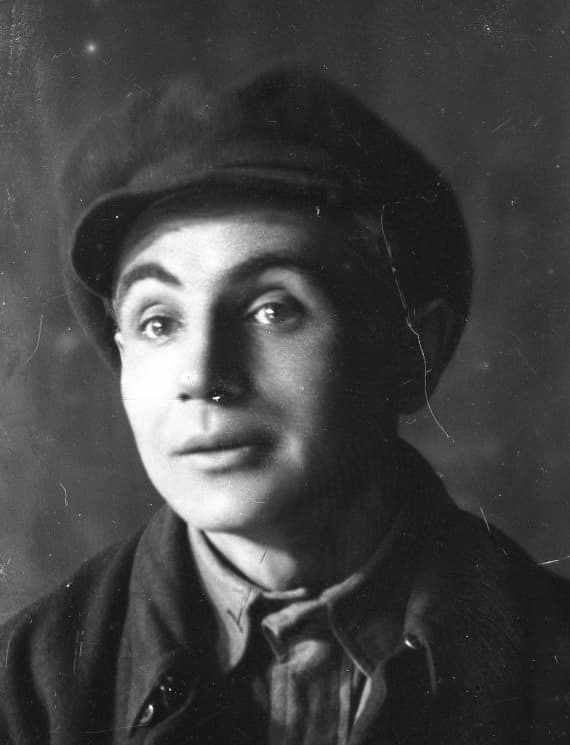Poem by Taras Shevchenko in 3 Acts
Premiere: March 10, 1920 in Kyiv
Director: Les Kurbas
Artist: Anatol Petrytskyi
Musical works by Mykola Lysenko, Kyrylo Stetsenko, Reinhold Glière, Naum Pruslin
Poet’s Ten Words:
First – Ryta (Kharytyna) Neshchadymenko
Second – Orysia (Iryna) Steshenko
Poland -Mariia Stukachenko (Prologue – “Slavery” pantomime)
Honta – Ivan Marianenko
Zalizniak – Danyloa Antonovych, Les Serdiuk
Tytar – Hryts Pelashenko
Oksana, His Daughter – Valentyna Chystiakova, Kateryna Osmialovska
Yarema – Favst Lopatynskyi
Leiba – Oleksandr Mishta, Volodymyr Kalyn
His Wife – Kateryna Lebediva
His Daughter – Kateryna Hudim-Levkovych
Colonel of the Confederates – Oleksandr Ostashevskyi
Kobzar – Vasyl Vasylko
Reverend – Oleksandr Zaharov
Zaporozhzhian Cossack – Mykhailo Domashenko
Haidamaka – Fedir Radchuk
Jesuit Priest – Petro Myloradovych
Nun – Vanda Yanovycheva (Kurbas)
Haidamaks, Liakhy and Пeasants – artists of the theater
The opening of Kurbas’s adaption of Taras Shevchenko’s Haidamaky was timed to the Shevchenko Days in 1920. The show was in many ways the result of the Young Theater’s previous two seasons, although it was performed at the Taras Shevchenko State Ukrainian Theater where Les Kurbas’s troupe was combined with Oleksandr Zaharov’s troupe.
Shevchenko’s heroic historical poem is about the Koliivshchyna peasant rebellion led by Maksym Zalizniak and Ivan Honta. The poet glorified the rebellious people for their will to fight against social and national oppression, their courage and spiritual beauty.
This was the first innovative show in Ukraine that embodied Kurbas’s principles of synthetic theater. The power of the show’s synthesis of art was impressive. The director brought together all means of expression and forms of art (pictorial, musical, choreography, pantomime, lighting, etc.) in this legendary show. Critics highlighted the music by composer Reinhold Glière and visual images by artist Anatol Petrytskyi, which embodied the director’s new approaches to music and set design.
The “poor” set design consisted of gray sackcloth that covered the stage. A simple apparatus was pulled from wing to wing. The ordinary village clothes of the ten women, the so-called Poet’s Ten Words, was made of the same sackcloth. All the other characters were dressed in ethnographic-concert folk costumes that were borrowed from the famous Leifert costume shop. The characters in bright costumes stood out against the gray stage while the characters in gray burlap merged with it.
The play consisted of individual episodes that were united by reactions of the Poet’s Ten Words. Director Volodymyr Halytskyi recalled: “In the center of the stage episodes of Haidamaky stretched continuously, or as quickly changing stills, or in the form of dramatic action.”
Kurbas’s idea was that the Poet’s Ten Words would play the role of an ancient chorus and explain what was happening between acts and behind the scenes, make remarks, express their attitude to the events on stage, sometimes even play the role of living scenery. They sympathized with lovers Oksana and Yarema and were concerned about the fate of Leiba, who was mocked by the confederates. And when Honta (Ivan Marianenko) asked them for sympathy after killing his own children backstage, the girls immediately turned away from him in condemnation of his terrible sin. They merged with the gray background, dissolved in it, leaving Honta alone with this own conscience. Beliefs were more important to him than family.
Artist Yakiv Strukhmanchuk said: “Director Les Kurbas introduced an interesting form of performance where movement and melodic choral recitation were combined with nearly all forms of art: acting, movement, music, speaking, singing, scenery and costumes. By using Shevchenko’s famous poem as the plot Kurbas wanted to give us a majestic and powerful show, to create a mystery with a prologue and chorus like in an ancient Greek tragedy, with mass scenes full of dynamics, with great pathos and gesture, while setting everything to musical rhythm.”
The innovative Haidamaky was Kurbas’s flagship as a director and was extremely popular among the audience. He staged Taras Shevchenko’s poetic masterpiece multiple times at theaters he directed (and others) and created an important precedent in national stage culture. In Bila Tserkva that year Les Kurbas recreated the show with the traveling Kyidramte (Kyiv Dramatic Theater) in a somewhat simplified form that was adapted to the local club stage. In it he played the role of Ivan Honta.
In 1922 Kurbas moved Haidamaky to the stage of the Maria Zankovetska National Theater in Lviv. Leading Ukrainian actors starred in the show: Oleksandr Korolchuk played Honta, Borys Romanytskyi was Yarema, and Liubov Linytska was the nun.
In 1924 Les Kurbas repeated the 1920 production at the 4th Theater Workshop of the Berezil Artistic Association in Kyiv. The image of Leiba that was created by Yosyp Hirniak and Amvrosii Buchma was overemphasized in it.
The Berezil Theater opened its 1930-31 season with a new directorial version of Haidamaky in its renovated Kharkiv building.
During the 20th century, dozens of theaters performed Les Kurbas’s version of Haidamaky from early 1919 (a new edition was published by Knyhospilka in 1926) and it became one of the greatest works of Ukrainian dramaturgy.

